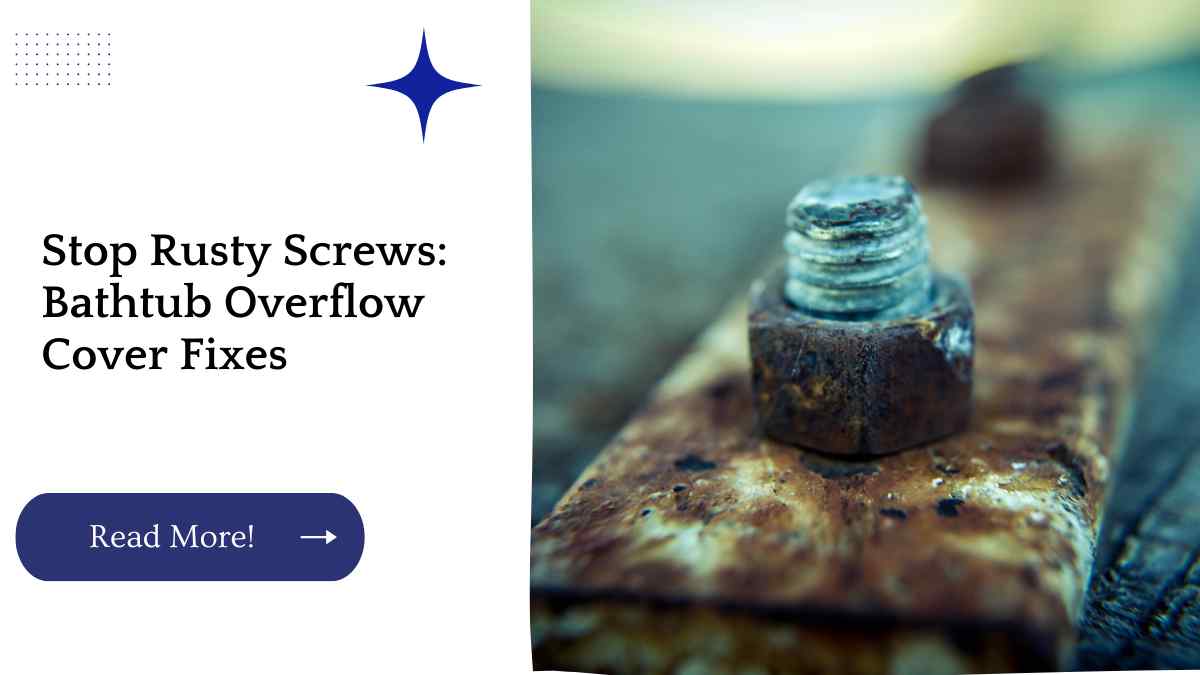A bathtub overflow cover is an essential part of any bathroom, as it prevents water from overflowing and causing damage. However, the screws that hold the cover in place are susceptible to rust, which not only looks unappealing but can also cause safety issues.
In this article, we’ll discuss several ways to stop rusty screws from ruining the appearance and functionality of your bathtub overflow cover.
| Key Takeaways |
|---|
| Rusty screws on bathtub overflow covers can be unsightly and potentially dangerous. |
| Screws rust due to exposure to water, moisture, and oxygen. |
| Preventing screws from rusting requires proper ventilation, using rust-resistant screws, and avoiding harsh chemicals. |
| Rusted screws can be removed using penetrating oil, screwdrivers, and pliers or by drilling them out. |
| Replacing rusty screws requires purchasing new screws and following the installation steps carefully. |
| A loose bathtub overflow cover can be fixed by replacing worn-out screws or a faulty gasket. |
| Painting a bathtub overflow cover can be a cost-effective solution to covering up rust stains. |
| Adhesive strips can provide a temporary fix for rusty screws but may not be suitable for all types of bathtub overflow covers. |
| Upgrading to a new bathtub overflow cover may be the most effective solution for preventing rusty screws altogether. |
Why do screws rust?
Screws rust due to exposure to water, moisture, and oxygen. When metal comes in contact with these elements, it undergoes a chemical reaction that produces rust.
Looking for a way to avoid water damage in your bathroom? Check out our article on fixing your shower’s drywall for some tips on how to prevent leaks and protect your walls.
The rust can weaken the screws, making them less effective and prone to breaking. Rusty screws can also cause unsightly stains on your bathtub and other bathroom fixtures.
How to prevent screws from rusting
Preventing screws from rusting requires taking a few precautions. Firstly, ensure that your bathroom is well-ventilated to reduce moisture buildup. Secondly, consider using stainless steel screws that are rust-resistant.
Lastly, avoid using harsh cleaning chemicals that can corrode the screws and cause them to rust faster.
Removing rusted screws
Removing rusted screws requires a bit of patience and elbow grease. Firstly, apply a penetrating oil to the screws and let it sit for several hours to loosen the rust.
Next, use a screwdriver or pliers to try and unscrew the screws. If they won’t budge, try tapping the end of the screwdriver or pliers with a hammer to break the rust seal. If all else fails, you may need to drill out the screws.
Are you tired of constantly draining water heaters? Our comprehensive guide on saying goodbye to constantly draining water heaters shares some simple solutions to help you avoid this problem and keep your bathtub in good shape.
Replacing rusty screws
If your screws are too far gone to be saved, you’ll need to replace them. Firstly, remove the old screws by following the steps outlined in the previous section.
Next, purchase replacement screws that are the same size and length as the old ones. Finally, screw in the new screws, making sure to tighten them securely.
Fixing a loose bathtub overflow cover
If your bathtub overflow cover is loose, it may be due to worn-out screws or a faulty gasket. Firstly, remove the screws holding the cover in place and inspect them for wear and tear.
If they look fine, check the gasket for any signs of damage or deterioration. If the gasket is the issue, replace it with a new one. If the screws are the issue, replace them following the steps outlined in the previous section.
Finding the right drainage pipe for your driveway can be tricky. Our guide on finding the right drainage pipe has everything you need to know to choose the right option for you and keep your plumbing fixtures in good shape.
Painting the bathtub overflow cover
If your bathtub overflow cover is still in good condition but has unsightly rust stains, consider painting it. Firstly, remove the cover and sand it down to remove any rust or rough spots. Next, apply a primer to the cover, followed by two coats of rust-resistant paint. Finally, allow the cover to dry completely before reinstalling it.
Using adhesive strips
If you’re looking for a temporary fix for your rusty screws, consider using adhesive strips. These strips adhere to the bathtub and the underside of the overflow cover, holding it securely in place without the need for screws.
However, keep in mind that adhesive strips may not be as durable as screws and may need to be replaced more frequently. Additionally, adhesive strips may not be suitable for all types of bathtub overflow covers, so be sure to check the packaging for compatibility.
When it comes to bathroom overflow cover, the possibility of water damage is always present. Our article on how to use shower shut off valves talks about an essential topic that can help you prevent this situation.
Upgrading to a new bathtub overflow cover
If all else fails, consider upgrading to a new bathtub overflow cover. Newer models are often designed to be rust-resistant and may come with more secure mounting options that eliminate the need for screws altogether.
When shopping for a new cover, be sure to measure the dimensions of your existing cover and choose a model that is compatible with your bathtub.
Do you want to avoid a massive plumbing bill for fixing your shower leak? Check out our article on quick and easy fixes for basement shower leaks to find some simple solutions to common plumbing problems and how to fix them in no time
Further Reading
Here are some additional resources on fixing rusty screws on bathtub overflow covers:
How to Remove Rusted Overflow Drain Screws: This article provides detailed steps on how to remove rusted screws on a bathtub overflow cover, including the use of penetrating oil, pliers, and screwdrivers.
Bathtub Overflow Cover Screws Rusted? 5 Quick Fixes to Repair: This article offers five quick fixes for repairing rusty screws on bathtub overflow covers, including using adhesive strips, painting the cover, and upgrading to a new cover.
Broken Screw on Overflow Pipe: This forum thread discusses various methods for removing broken screws on bathtub overflow pipes, including the use of screw extractors and drilling out the screws.
Conclusion
Rusty screws on your bathtub overflow cover can be a nuisance, but they don’t have to be a permanent fixture.
By following the steps outlined in this article, you can prevent screws from rusting, remove and replace rusty screws, fix a loose bathtub overflow cover, paint the cover, use adhesive strips, or upgrade to a new cover altogether.
With a little bit of effort, you can restore the appearance and functionality of your bathtub overflow cover and enjoy a safer and more comfortable bathroom experience.
FAQs
How often should I replace rusty screws on my bathtub overflow cover?
A1. It’s best to replace rusty screws as soon as possible to prevent further damage to your bathtub and reduce the risk of injury.
Can I use any type of screw on my bathtub overflow cover?
A2. It’s best to use stainless steel screws that are rust-resistant and designed for use in bathrooms.
How do I know if my bathtub overflow cover needs to be replaced?
A3. Signs that your bathtub overflow cover needs to be replaced include cracks, warping, and excessive rust or corrosion.
Can I paint my bathtub overflow cover any color?
A4. Yes, you can paint your bathtub overflow cover any color you like, as long as you use a rust-resistant paint that is suitable for use in bathrooms.
Can I install a new bathtub overflow cover myself?
A5. Yes, you can install a new bathtub overflow cover yourself, but it’s important to follow the manufacturer’s instructions carefully and ensure that the cover is properly secured.

Hellen James is the author of the blog and a licensed plumber with over 15 years of experience. She shares her knowledge and experience in plumbing and drainage through insightful and informative articles

